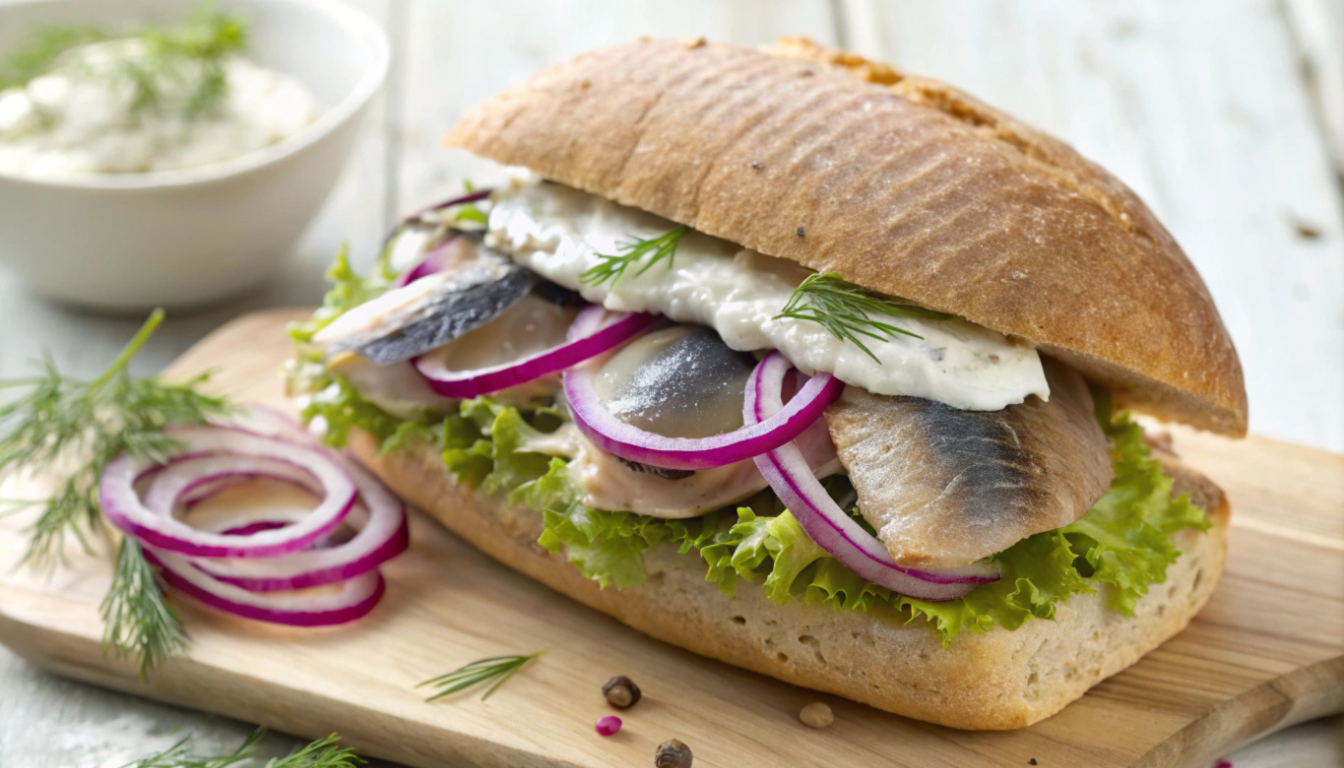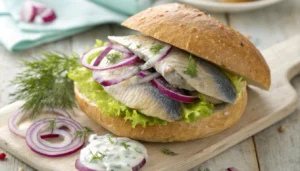When you think of German cuisine, what comes to mind? Perhaps German sausages, pretzels, or schnitzels? But have you ever tried a unique and flavorful Matjesbrötchen recipe? This traditional sandwich combines the delicate, salty-sweet flavor of Matjes herring with fresh bread rolls and crunchy, vibrant toppings. A specialty from Northern Germany, the Matjesbrötchen is a culinary delight that deserves a place on your food radar. Curious about how to prepare this classic dish? Let’s dive into its rich history, explore the key ingredients, and walk through the step-by-step process to make the perfect Matjesbrötchen. Plus, we’ll share tips to ensure your sandwich is as authentic and delicious as possible.
Understanding the German Culinary Heritage Behind matjesbrötchen recipe
To fully appreciate matjes herring rolls, or matjesbrötchen, we must explore the Netherlands’ rich culinary history. This dish has its origins in the nation’s maritime heritage and cultural customs.
Origins of Matjes Herring in Traditional German Cuisine (matjesbrötchen recipe)
The Germans’ close location to the North Sea has greatly influenced its cuisine. Matjes herring is a key ingredient, known for its light saltiness and fermentation. For centuries, it has been a favorite in Germany kitchens.
Fishermen and coastal communities valued it for its taste and nutritional value.
Cultural Significance of Open-Faced Sandwiches
The German also cherish open-faced sandwiches, known as open-faced herring sandwiches. These simple dishes are a big part of traditional germany cuisine. They are frequently eaten as a quick snack or lunch.
The open-faced format highlights the natural flavors of the ingredients. Enjoying the delicate matjes herring in this way is the perfect method.
By understanding the historical and cultural background, we can truly value the craftsmanship and tradition in making the perfect matjesbrötchen.
“The open-faced sandwich is a testament to the German reverence for high-quality, flavorful ingredients that allow each component to shine.”
Essential Ingredients for Authentic Matjesbrötchen recipe
Making the perfect matjesbrötchen, a favorite German open-faced sandwich, needs top-notch ingredients. At its core are the matjes herring fillets, a German favorite for centuries. These tender, lightly cured herring fillets, paired with a fresh Germany brötchen, offer a perfect mix of flavors. It’s like stepping into the charming cafes and markets of the germans.
To make a real matjesbrötchen, you’ll need these key ingredients:
- Matjes Herring Fillets: These premium, lightly salted and gently pickled herring fillets are the main attraction. Their delicate, slightly sweet taste and soft texture are what make a true matjesbrötchen.
- Germany Brötchen: A soft, fluffy bread with a slightly crisp crust, the brötchen is the perfect base for the herring. It’s crucial to pick a high-quality, freshly baked brötchen to match the matjes’ flavors.
- Garnishes and Accompaniments: Traditional matjesbrötchen often come with toppings like thinly sliced red onion, chopped chives, a squeeze of lemon juice, or a dollop of crème fraîche or sour cream.
With these key matjesbrötchen ingredients and a dash of creativity, you can make this beloved Germany sandwich in your kitchen.
“For more recipe ideas, explore our Recipes & Dishes homepage.”
Selecting the Perfect Matjes Herring Fillets
Creating an authentic matjesbrötchen starts with top-notch matjes herring fillets. These fish are the main attraction, so picking them wisely is crucial. Whether making a german herring sandwich at home or following a traditional recipe, knowing how to choose the best matjes herring is key.
How to Identify Quality Matjes Herring
Spotting high-quality matjes herring is easy if you know what to look for:
- Bright, glistening skin with a vibrant silvery-blue color
- Firm, plump flesh that springs back when gently pressed
- A delicate, mild aroma with no fishy or unpleasant odors
- Fillets that are uniform in size and shape, with minimal blemishes
Storage and Preparation Tips
After finding the perfect matjes herring fillets, it’s vital to store and prepare them right. This keeps their fresh, delicate taste intact. Here’s how:
- Keep the fillets refrigerated at 40°F (4°C) or below until ready to use
- If freezing, wrap the fillets tightly in plastic or foil to prevent freezer burn
- Gently rinse the fillets under cool water before use, being careful not to break them
- To remove any excess moisture, pat the steaks dry with paper towels.
Fresh vs. Preserved Herring Options
When it comes to matjes herring fillets, you can choose between fresh and preserved. Fresh herring gives a delicate flavor. Preserved herring, cured or pickled, has a more intense taste. Think about your taste and the recipe you’re using to decide between fresh and preserved.
The Complete Matjesbrötchen Recipe
Are you ready to explore the world of traditional matjesbrötchen? This german open-faced sandwich is a treat, mixing cured herring with a soft brötchen base. Follow this recipe to make your own german brötchen at home.
Ingredients: (matjesbrötchen recipe)
- 4-6 slices of freshly baked brötchen or other small, soft rolls
- 8-10 ounces of high-quality matjes herring fillets, drained and sliced
- 2 tablespoons of creamy horseradish sauce
- 1 small red onion, thinly sliced
- Fresh dill sprigs for garnish
- Lemon wedges for serving
Start by arranging your brötchen or rolls on a clean surface. Spread creamy horseradish sauce on each slice. Then, place sliced matjes herring on top, slightly overlapping for a nice look.
“The use of premium, freshly cured herring fillets is essential to creating a genuinely authentic matjesbrötchen.”
Top your sandwiches with thin red onion slices and a sprig of fresh dill. Serve with a lemon wedge on the side. This lets guests add a squeeze of citrus to their taste.
Enjoy the mix of briny, creamy, and tangy flavors in your homemade germany brötchen.
Preparing the Perfect Brötchen Base
Creating the perfect matjesbrötchen starts with the base. Choosing the right bread and toasting method is key. These steps affect the texture and taste of this german open-faced sandwich. Let’s explore how to pick the best brötchen and toast it to perfection.
Bread Selection Guidelines
For a true matjesbrötchen, choose a traditional germany brötchen or a similar soft bread. Look for a bread that’s sturdy but still soft. Brioche or a lightly sweetened kaiser roll are great choices. Their rich flavor pairs well with the salty matjes herring.
Toasting Techniques for Optimal Results
Toasting the brötchen is crucial. It makes the bread crispy on the outside and soft inside. This adds texture and prevents the bread from getting soggy with the toppings.
To toast perfectly, use a toaster or a skillet with a bit of oil. Toast until it’s lightly golden. This way, the bread is firm enough to hold the toppings but still soft.
“The perfect brötchen is the foundation for a delicious matjesbrötchen. With the right bread and toasting technique, you can create a harmonious balance of flavors and textures.”
By following these tips, you’ll make a top-notch open-faced german brötchen. It will highlight the flavors of the matjes herring beautifully.
Creative Matjesbrötchen recipe Toppings and Garnishes
Make your open-faced herring sandwich better with tasty matjesbrötchen toppings and garnishes. You can change these sandwiches to match your taste.
Use the freshest seasonal produce first. Crisp radish slices, juicy cucumber rounds, and peppery arugula leaves add a nice crunch. Cherry tomatoes or thinly sliced red onion bring color.
- Radish slices
- Cucumber rounds
- Arugula leaves
- Cherry tomatoes
- Red onion
Add flavor with fresh herbs like dill, chives, or parsley. These herbs can make your matjesbrötchen toppings special.
“A well-curated topping selection can truly elevate the humble matjesbrötchen into a work of art.”
Try creamy toppings like crème fraîche, tangy yogurt, or nutty pesto. They balance the bold herring flavors well.
Try different toppings to find your favorite. You can stick to classic or try new things. The choices are endless for these open-faced herring sandwiches.
“For more recipe ideas, explore our Recipes & Dishes homepage.”
Expert Tips for Assembly and Presentation
To make your matjesbrötchen look amazing, pay close attention to detail. You’ll need to know about layering and traditional plating. These tips will help you create a germany herring sandwich that’s a feast for the eyes.
Layering Techniques for Beautiful Presentation
Start with a lightly toasted brötchen as the base. Then, place the matjes herring fillets on top, overlapping them slightly. Next, add thinly sliced red onions and a dollop of creamy remoulade sauce.
Finish with a sprinkle of fresh dill or chives. This adds a burst of color and freshness.
Traditional Plating Methods
In the german, matjesbrötchen are served on wooden or ceramic platters. This lets the sandwiches be the main attraction. Place each sandwich on a plate or serving board, arranging them nicely.
To add elegance, garnish with lemon wedges, cornichons, or a sprinkle of paprika.
The way you present your matjesbrötchen is just as crucial as the taste. By mastering layering and plating, you can turn this classic Dutch herring sandwich into a true masterpiece.
Seasonal Variations and Modern Twists
As the seasons change, so can your approach to the classic matjes herring rolls, or matjesbrötchen. This dish is a favorite in traditional germany cuisine. Try new flavors that go well with the herring while keeping the dish’s roots alive.
In spring, pair matjes with fresh radishes, asparagus, or greens. These crisp flavors will stand out against the herring’s richness. Summer brings ripe tomatoes, cucumber, and dill, adding a cool twist to your rolls.
Autumn calls for warm spices like cinnamon or nutmeg. Add apples or pears for a seasonal touch. Winter brings roasted beets, horseradish, or smoked cheese for a cozy matjes experience.
Modern chefs are adding their own twist to matjes herring rolls. They use pickled onions, wasabi crème fraîche, and creative plating. This keeps the dish fresh and exciting for today’s tastes.
“The beauty of the matjesbrötchen lies in its ability to evolve with the seasons and the creative vision of the cook. By embracing new flavors and techniques, we can preserve the essence of this timeless dish while delighting the modern palate.”
Pairing Suggestions and Serving Recommendations
Enjoying a classic german herring sandwich, or matjesbrötchen, is even better with the right pairings. Discover the flavors that go well with this beloved dish. It’s a great way to dive into traditional germany cuisine.
Traditional Beverage Pairings
For a perfect match, try a refreshing drink with your matjesbrötchen. A cold glass of Genever, the german gin, is a great choice. Or, a classic Heineken beer can also complement the sandwich well.
Side Dish Options
- Creamy potato salad: A cool, creamy potato salad is a nice contrast to the savory matjesbrötchen. It makes for a complete meal.
- Fresh vegetable slaw: A crunchy, tangy vegetable slaw, like koolsla (Dutch cabbage salad), adds a refreshing touch.
- Pickled vegetables: Traditional german pickles, like augurken (pickled cucumbers) or zilveruitjes (pickled onions), provide a tangy complement.
Pairing the dutch herring sandwich with the right drinks and sides lets you fully enjoy Dutch culinary heritage.
“For more recipe ideas, explore our Recipes & Dishes homepage.”
Common Mistakes to Avoid When Making Matjesbrötchen
When making matjesbrötchen, watch out for a few common mistakes. First, use only the best matjes herring. This ensures the best taste and texture. Also, don’t add too many toppings, as it can mess up the flavors.
Another mistake is not preparing the brötchen base right. Toast your bread lightly for the right crunch. Make sure the bread and toppings are in balance. Too soggy or dry can ruin the dish.
Lastly, don’t be afraid to get creative with your garnishes and sides. Try fresh herbs, citrus zest, or olive oil. By avoiding these mistakes and adding your own touch, you’ll make a great matjesbrötchen recipe. Enjoy the authentic german brötchen recipe flavors.
FAQ
What is a matjesbrötchen?
A matjesbrötchen is a german open-faced sandwich. It has pickled herring, called matjes herring, on a toasted brötchen.
What are the key ingredients in a traditional matjesbrötchen?
For a real matjesbrötchen, you need good matjes herring fillets. Also, fresh brötchen or German-style rolls are key. Don’t forget the traditional toppings like chopped onion, gherkins, and sour cream.
Where does the tradition of matjesbrötchen originate?
Matjesbrötchen is a big part of german food culture. It comes from a long history of seafood and simple, tasty dishes.
How do I select the best quality matjes herring for my matjesbrötchen?
Choose matjes herring that’s plump, firm, and shiny. Make sure it’s sustainably caught and well-preserved for the best taste.
What are some creative topping ideas for matjesbrötchen?
Try adding diced apples, shredded cabbage, or crumbled hard-boiled egg. A drizzle of honey can also add something special.
How can I achieve the perfect toasted brötchen for my matjesbrötchen?
Slice the rolls in half and toast them until golden. This makes a crispy base for your matjesbrötchen.
Are there any seasonal or modern variations on the classic matjesbrötchen?
Yes! You can use fresh berries or roasted veggies in summer. For a fancy twist, try smoked salmon or crème fraîche.
What are some common mistakes to avoid when making matjesbrötchen?
Don’t use bad herring or over-toast the brötchen. Too many toppings can ruin it. Choose quality ingredients and keep it simple for the best taste.




1 thought on “Try This Classic Matjesbrötchen Recipe Today”